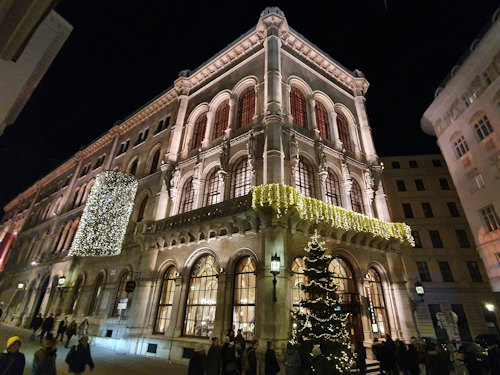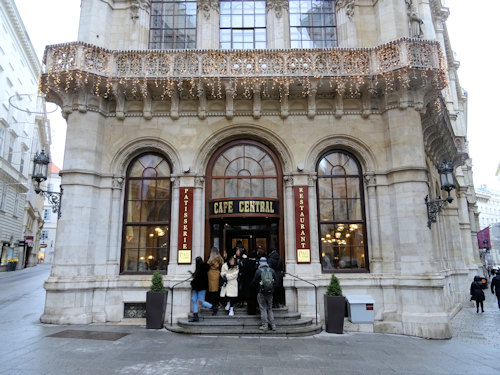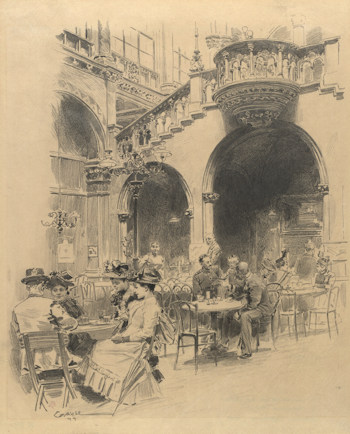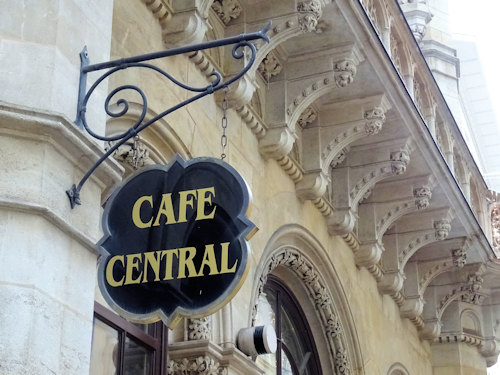
Well, my mouth dropped open on entering. There’s a reason Café Central is so popular with tourists. Inside is like stepping into a period drama set.
- Stunning vaulted palatial interior
- Once the haunt of Freud, Trotsky, and others
- The cake display is a work of art
- But…go early or reserve a table if you don’t want to queue
- Book a culinary experience* for your Vienna trip
- See also:
Cake, coffee & history

(The café during a previous Christmas season)
Back in the day, I used to walk past Café Central regularly and always see a queue outside. “Clearly a tourist trap,” I used to say to myself. And Vienna had plenty of other coffee houses to feed my caffeine addiction.
But then curiosity got the better of me. Thank you, curiosity…I owe you one.
Walk through the door, and a majestic, vaulted, and columned room opens up before you.
And just as you thought your jaw could not drop any lower, the cake display hits you; they should move it to the Albertina, for it is a work of art in its own right.

(The cake counter occupies the centre; press photo © Café Central / Christian Husar)
So, yes, call me impressed.
Now, a place of such magnificence has to have a catch and it’s usually the staff. Ah, wrong again.
We were welcomed warmly on entering and, watching from afar, I could see waiters chatting and smiling with each other. Smiling! I had to check I was still home in Vienna.
Our waiter was particularly friendly, fast, and thoughtful.

(Unusually, barely a queue in sight)
For example, Café Central has an in-house patisserie to create those pieces of culinary art, and my wife’s slice of cake automatically arrived with two forks – just in case I might like a taste.
Incidentally, those cakes felt more unique than in your average coffee house. The selection seemed to avoid standard cake varieties in favour of original creations.
After presenting a bill, the waiter would always pull back a step or two to give fumbling people time and space to find their money. No pressure, not even with a queue outside.
Ah, yes, the queues.

(Wilhelm Gause (Artist), the Arkadenhof in the old Café Central premises, 1899, Sammlung Wien Museum, reproduced with permission under the terms of the CC0 licence)
We went at 8am, midweek, in early February and had no trouble getting a table immediately.
But be warned: queues are likely later in the day and pretty much anytime outside late January and early February.
But let’s get back to those little touches that go beyond the usual coffee house experience, like organic breakfast butter scoring 10/10 on the spreadability index, the white tablecloth, a genuinely crusty roll, the jam in a sealed collectible jar you can take with you…
And…a little chocolate with your coffee. I could go on.
Consider the traditional coffee house checklist duly ticked, too: red patterned upholstery, burnished metal lamp fittings, brown marble tabletops on wood and brass pedestals, and those classic worn bentwood coffee chairs.
And everything spotless.
The building itself (Palais Ferstel) dates back to the mid-19th century and once housed the Vienna Stock Exchange and the National Bank. You can tell. The same architect designed the Votivkirche church and the MAK museum.
At one end of the coffee house, you may even breakfast beneath portraits of Emperor Franz Joseph and Empress Elisabeth. A little kitsch, perhaps, but then Café Central did open in 1876 during their reign.
An advertisement in the April 16th edition of the Die Presse newspaper announced that opening, with the owner (W. Prückel) noting that he had (my rough translation):
…furnished it in the most elegant manner in the parterre areas known for their architectural beauty

(An interior view of Café Central from 1902, as painted by Marie Adler; Wien Museum Inv.-Nr. 41024; excerpt reproduced with permission under the terms of the CC0 licence)
Mr Prückel was also, it seems, rather proud of the four billiard tables “of the newest construction”: perhaps the very tables in the 1902 painting above.
In the years that followed, the location grew into a meeting place for the intelligentsia of Vienna and beyond.
Freud drank here. As did Kokoschka, Loos and Schnitzler. But also Trotsky. Probably Tito, Stalin and Lenin. And perhaps even a young Hitler, though you won’t find that possibility mentioned much.
Palais Ferstel actually suffered significant damage in WWII and Café Central closed, only reopening in the 1980s: a place still rich in tradition, given that guest list and history.

(Outside on Herrengasse)
The extensive menu stretches through the day from breakfast into snacks, lunches, and evening meals, with a strong focus on traditional Viennese cuisine (with alternatives), regional products, and organic food.
Café Central is certainly not cheap, but I actually thought it would be more expensive given the location and popularity.
(Tip: the classic Viennese breakfast or Wiener Frühstück comes with coffee included, which makes it considerably cheaper when you see how much you could pay for a coffee on its own.)
In the course of the morning, numerous tourists popped in, brandishing smartphones and posing beside the cakes. But then who wouldn’t?
However, various well-to-do locals also joined us, and the atmosphere remained discreetly traditional despite the mix of guests. What happens at peak hours, though, I cannot say.
All-in-all, if you don’t mind the possible wait if you don’t reserve a table, Café Central qualifies as a priority on your Vienna itinerary.
How to get to Café Central
The name is a bit of a giveaway when it comes to location. Café Central sits right in the centre
This area consists largely of one palais after the next. For example, the building opposite is Palais Niederösterreich, the neighbour on one side is Palais Hardegg, and the neighbour on the other side is Palais Orsini-Rosenberg (Palais Batthyány).
Pop up Strauchgasse to find the Freyung square, home to seasonal markets and a variety of historical buildings. Or continue south down Herrengasse to reach Michaelerplatz and the Habsburg’s Hofburg palace complex.
Subway: the Herrengasse station on the U3 line is very close
Tram/bus: the trams don’t go through the centre, but buses 1A and 2A both also stop at Herrengasse
Address: Herrengasse / Strauchgasse, 1010 Vienna | Website